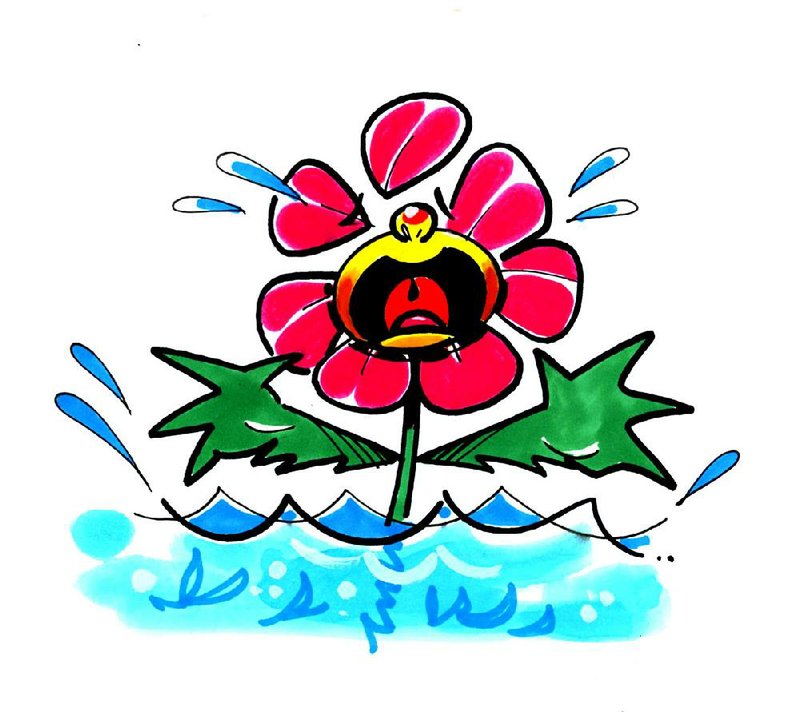Q My front yard has standing water every time after a hard rain. Two years ago, I put down topsoil on flooded spots. What should I do, install a French drain? Put more soil or sand down?
A Water has to go somewhere. Are you the low spot in the neighborhood? Where is the water coming from? How long does it stay? Simply raising the level of the ground could help stop it from getting to your front yard, but it is still going to enter the yard. Underground drains or dry creek beds that help move it or direct where it goes can help; but from the pictures, your yard looks pretty level, so I don't see how you are going to get the water to move out. Another possibility is to put in a rain garden, which can handle the excess water when it comes in and filter it out. A fact sheet on rain gardens and storm water can be found among the publications at uaex.edu; search for FSA-9533.
Q This crape myrtle is 13 years old. How much and when should I prune?
A Normally we would prune crape myrtles in late February, but this year crape myrtles are just now beginning to leaf out, thanks to our late spring, so there is still time to prune. I love that you haven't butchered this beautiful specimen. I like the height and the size of the trunks, but I think you have too many trunks. I would try to thin out a couple of the trunks at the soil line to allow the remaining trunks to have room to grow, and do a bit of thinning about midway up where you seem to have a wealth of stems. Otherwise, I would let it be.
Q Can you identify this weed (see picture) that is prevalent in my zoysia grass lawn this year? What weed-killer can I use in the Little Rock area to get rid of it?
A The weed is commonly called annual bluegrass or Poa annua. It is a winter weed that you have waited too late to control. The little seed heads you see on top are why it will come back to haunt you next year. For now, you could try mowing the weeds to prevent any more seeds from forming, but it will die back with hot weather. As cool as it has been, it may linger a bit longer than we would like, but since it is an annual weed, it dies back at the end of the season. It is a difficult weed to eradicate with one application of a pre- or post-emergent herbicide. A pre-emergent herbicide can be applied around Aug. 15. Revolver, TranXit or Monument can give you pretty good post-emergent control, but apply whatever you use before the end of the cool growing season. Simazine and atrazine can work as both a pre- and a post-emergent herbicide before the weeds are too well established.
Q The bark on the trunk and some branches of our flowering crab apple tree is peeling and shedding. Some of the branches look to be dead instead of starting to bud like the rest of the tree. Is there a remedy for this problem?
A Investigate a bit more. Occasionally branches are killed, and the bark will split and fall off. I have also seen several incidents this year in which squirrels or raccoons were stripping bark off Japanese maples and red maples. Also check to see if there are any holes near the damage where borers could have gotten in. I would scout for potential causes. If you don't see anything, take some pictures and a plant sample in to your local county agent. The agent can send the samples to the University of Arkansas Extension Service disease diagnostic lab.
Q Last week my wife and I cut back the Knockout roses she had me plant three years ago. The three in the backyard are doing great. The one pink one in the front had black spots all over. We cut it almost back to the ground. Is there anything I can do to save it, or would it be better to replace it?
A Most Knockout roses don't suffer from the common black spot of roses, but they can suffer from cercospora leaf spot fungus, which is similar but doesn't cause as much defoliation. I guess the question comes down to whether you want to spray or not. If not, give it one more growing season to see if the severe pruning helped. If the spots come back, pull it and plant something else. If you don't mind spraying, get a general purpose fungicide like Daconil and spray now, then see if spots occur. If they do, repeated applications may be necessary.
Janet B. Carson is a horticulture specialist for the University of Arkansas Cooperative Extension Service. Write to her at 2301 S. University Ave., Little Rock, Ark. 72204 or email her at
jcarson@arkansasonline.com
HomeStyle on 04/11/2015
